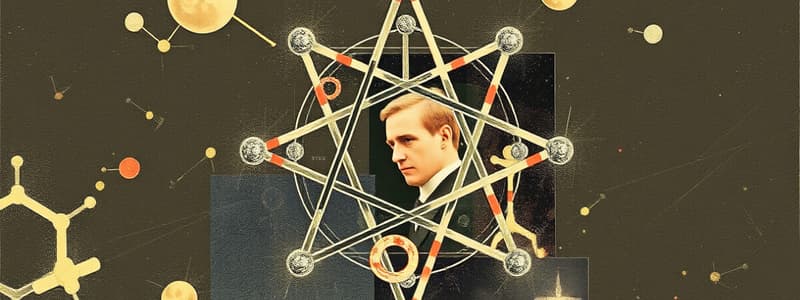Podcast
Questions and Answers
What is the primary characteristic of endothermic reactions?
What is the primary characteristic of endothermic reactions?
- They have higher energy reactants than products.
- They do not involve energy changes.
- They absorb heat from their surroundings. (correct)
- They release heat to the surroundings.
Which technique is used to separate liquids based on their boiling points?
Which technique is used to separate liquids based on their boiling points?
- Titration
- Filtration
- Evaporation
- Distillation (correct)
What does PPE stand for in a laboratory context?
What does PPE stand for in a laboratory context?
- Preventive Procedure Exercises
- Professional Performance Evaluation
- Physical Protection Essentials
- Personal Protective Equipment (correct)
Which of the following best describes a compound?
Which of the following best describes a compound?
What is electronegativity?
What is electronegativity?
What term describes a substance that cannot be broken down into simpler substances?
What term describes a substance that cannot be broken down into simpler substances?
Which particles determine the atomic number of an element?
Which particles determine the atomic number of an element?
Which type of bond is formed by the sharing of electrons?
Which type of bond is formed by the sharing of electrons?
What is the correct order of the reactions in a synthesis reaction?
What is the correct order of the reactions in a synthesis reaction?
In which state of matter do particles move freely and are far apart?
In which state of matter do particles move freely and are far apart?
What term describes the amount of solute per unit volume of solution?
What term describes the amount of solute per unit volume of solution?
What is the pH range of a strong base?
What is the pH range of a strong base?
What do we call the substances that undergo change in a chemical reaction?
What do we call the substances that undergo change in a chemical reaction?
Flashcards are hidden until you start studying
Study Notes
Basic Concepts of Chemistry
- Matter: Anything that has mass and occupies space; exists in solid, liquid, and gas states.
- Atoms: Basic units of matter; consist of protons, neutrons, and electrons.
- Elements: Pure substances made of only one type of atom; organized in the Periodic Table.
Atomic Structure
- Protons: Positively charged particles in the nucleus; determine atomic number.
- Neutrons: Neutral particles in the nucleus; contribute to atomic mass.
- Electrons: Negatively charged particles orbiting the nucleus; involved in chemical bonding.
The Periodic Table
- Groups: Vertical columns; elements in the same group have similar properties.
- Periods: Horizontal rows; represent energy levels of electrons.
- Metals, Nonmetals, and Metalloids: Different categories based on properties.
Chemical Bonds
- Ionic Bonds: Formed by the transfer of electrons; typically between metals and nonmetals.
- Covalent Bonds: Formed by the sharing of electrons; typically between nonmetals.
- Metallic Bonds: Involves a 'sea of electrons'; occurs in metals.
Chemical Reactions
- Reactants: Substances that undergo change during a reaction.
- Products: Substances formed as a result of a chemical reaction.
- Types of Reactions:
- Synthesis: A + B → AB
- Decomposition: AB → A + B
- Single Replacement: A + BC → AC + B
- Double Replacement: AB + CD → AD + CB
- Combustion: Hydrocarbon + O₂ → CO₂ + H₂O
Stoichiometry
- Mole Concept: A mole is 6.022 x 10²³ particles; used to relate mass and number of particles.
- Balancing Equations: Ensures the law of conservation of mass is followed.
States of Matter
- Solid: Fixed shape and volume; particles closely packed.
- Liquid: Fixed volume but takes the shape of the container; particles are close but can move.
- Gas: No fixed shape or volume; particles are far apart and move freely.
Solutions and Concentrations
- Solvent: Substance that dissolves the solute; usually in greater amount.
- Solute: Substance being dissolved; usually in lesser amount.
- Concentration: Amount of solute per unit volume of solution (e.g., molarity).
Acids and Bases
- Acids: Substances that donate protons (H⁺); have a pH less than 7.
- Bases: Substances that accept protons or donate hydroxide ions (OH⁻); have a pH greater than 7.
- pH Scale: Measures acidity or basicity; ranges from 0 (strong acid) to 14 (strong base).
Thermodynamics
- Endothermic Reactions: Absorb heat; reactants have lower energy than products.
- Exothermic Reactions: Release heat; reactants have higher energy than products.
Laboratory Techniques
- Titration: Technique to determine concentration of a solution.
- Filtration: Separation of solids from liquids based on particle size.
- Distillation: Separation based on boiling points of substances.
Safety in the Laboratory
- Personal Protective Equipment (PPE): Includes gloves, goggles, and lab coats.
- Emergency Procedures: Know the location of safety showers, eyewash stations, and fire extinguishers.
Key Terms
- Molecule: Two or more atoms bonded together.
- Compound: A substance formed when two or more different elements are chemically bonded.
- Electronegativity: Measure of an atom's ability to attract electrons in a bond.
Basic Concepts of Chemistry
- Matter is defined as anything with mass that occupies space, existing in solid, liquid, and gas forms.
- Atoms are the fundamental units of matter, composed of protons, neutrons, and electrons.
- Elements are pure substances consisting of only one type of atom and are arranged in the Periodic Table.
Atomic Structure
- Protons carry a positive charge and are located in the nucleus; they determine the atomic number.
- Neutrons, which have no charge, are also found in the nucleus and contribute to the atomic mass.
- Electrons are negatively charged and orbit the nucleus; they play a crucial role in chemical bonding.
The Periodic Table
- Groups are vertical columns in the Periodic Table; elements within the same group share similar properties.
- Periods are horizontal rows that indicate different energy levels of electrons.
- Elements are classified as metals, nonmetals, or metalloids based on their properties.
Chemical Bonds
- Ionic bonds are created through the transfer of electrons, usually between metals and nonmetals.
- Covalent bonds involve the sharing of electrons and commonly occur between nonmetals.
- Metallic bonds feature a 'sea of electrons' that allow for conductivity and malleability in metals.
Chemical Reactions
- Reactants are substances that undergo a transformation during a chemical reaction, while products are the substances created as a result.
- Chemical reactions can be categorized into:
- Synthesis (A + B → AB)
- Decomposition (AB → A + B)
- Single Replacement (A + BC → AC + B)
- Double Replacement (AB + CD → AD + CB)
- Combustion (Hydrocarbon + O₂ → CO₂ + H₂O)
Stoichiometry
- The mole concept defines a mole as 6.022 x 10²³ particles, serving as a bridge between mass and particle number.
- Balancing equations is essential to uphold the law of conservation of mass.
States of Matter
- Solids maintain a fixed shape and volume, with particles densely packed.
- Liquids possess fixed volume but adapt to the shape of their container; particles are close yet mobile.
- Gases have neither a fixed shape nor volume, with particles freely moving apart.
Solutions and Concentrations
- A solvent is the substance that dissolves the solute, typically existing in greater quantities.
- A solute is the substance that is dissolved within the solvent, usually in lesser amounts.
- Concentration reflects the amount of solute present per unit volume of solution, such as in molarity.
Acids and Bases
- Acids are proton donors (H⁺), characterized by a pH less than 7.
- Bases are proton acceptors or hydroxide donors (OH⁻) and have a pH greater than 7.
- The pH scale ranges from 0 to 14, measuring acidity (0 = strong acid, 14 = strong base).
Thermodynamics
- Endothermic reactions absorb heat, resulting in products with higher energy than reactants.
- Exothermic reactions release heat, with reactants holding more energy than the resulting products.
Laboratory Techniques
- Titration is used to ascertain the concentration of a solution.
- Filtration separates solids from liquids based on particle size.
- Distillation is a technique for separating substances based on their boiling points.
Safety in the Laboratory
- Personal Protective Equipment (PPE) includes gloves, goggles, and lab coats to ensure safety.
- Familiarize yourself with emergency procedures and locations of safety showers, eyewash stations, and fire extinguishers.
Key Terms
- A molecule consists of two or more atoms bonded together.
- A compound forms when two or more different elements chemically bond.
- Electronegativity gauges an atom's capacity to attract electrons within a bond.
Studying That Suits You
Use AI to generate personalized quizzes and flashcards to suit your learning preferences.




